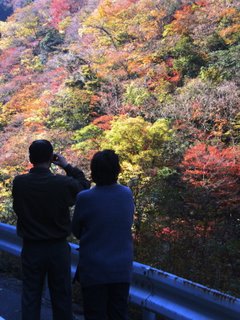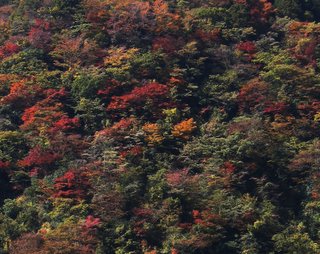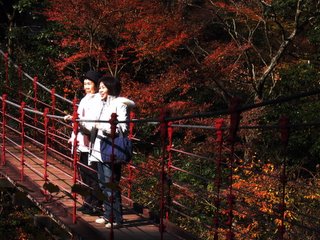















So. Today was sunny and sweet, so Jesse and I went on a hike looking for monkeys. We hiked up to “Minetopia” which is like an amusement park of sorts for the old Copper Mine town. I will return to that part of the journey later. Now, let me take you up to the sacred waterfall where we saw hundreds of people participating in the great “momiji gari” or “hunting for maples.” As it is in the spring with the cherry blossoms, Japanese people love their maple trees changing in autumn. They take long car trips across the land in search for beautiful Maple trees to take pictures of and to smile at. Do we have anything like this in the States? Maybe. We definitely go looking for the Grand Canyon, or the redwoods, or the big waterfalls, but would we take a trip to go look for maple trees or cherry blossoms?
So, great day, we saw some monkeys, and some blood red maples. Quilted mountains, the curtain, and on center stage, the monkeys. What is better than watching monkeys play in red and yellow trees?
We walked up to the waterfall (about an hour and a half) and walking back a nice young couple stopped and gave us a lift. They drove about and hour to see the maples by the waterfall and loved practicing English with us. We got off at Minetopia to visit “Healthy Land,” the onsen (public bathhouse) on the top floor. This bathhouse was huge and part of it was outside. It was like a big water park. Only, everyone was naked.
I think one reason I might be blogging for you all is to convince you to come and visit this place. Seriously. You can stay in my apartment for free. You wont regret it. I mean, I know that when people show you all their great pictures from their vacations it can be boring and might even produce some envy ("hey! Check out this awesome place I visited and you didn’t!), but I hope my pictures inspire a deeper appreciation for nature, color, and pattern, as well as a new desire to visit this holy land. Maybe that’s not so good. Maybe im spreading desire and envy. Or, even worse…boredom. Well, either will be worthwhile if you take a deep breath right now and take a moment to remember that you are alive and that you will die, probably sooner than you think.
I just finished reading “The curious incident of a dog in the night-time.” Great read. I also recommend that.
This morning I was meditating and Kieran stated playing some music. I was in the middle of reciting a mantra and following the mantra down to its source, which is the empty field of pure awareness (see note for further information about mantra meditation) and I immediately felt annoyed that he would be playing music while I was meditating and the correlated thought, which was “why is he playing music while im meditating?” arose out of the same field of awareness as the mantra did, only it was louder and harsher. But I gave it plenty of space, and I watched it arise out of the ocean of awareness that I am like a wave and it disappeared into the ocean of awareness that I am like a wave, and the mantra returned. And I watched it. And they way that the thought and feeling of annoyance flowed through me like a river, or flew through me like a bird or a cloud, well, it made me feel more spacious than I did when it was quite. So, moral of the weird little story: annoyances can be liberating.
Note. Using a mantra is part of Mahayana, Vajrayana (also known as the “Mantra-yana.” Or tantric Buddhism, but it is also used in one way or another by most every religious tradition in the world. "Mantra" literally means, "mind protector." And this practice is very, very powerful.
In most cases, the mantra is not meant to have a specific meaning (although mantras that have meaning are very useful and beneficial too). Most mantras are meant to be powerful simply because they are sounds. And sounds, when they are thought, represent the finest or subtlest lever of thinking possible. (just try it now. Think the thought “hoom” and see how your entire mind was flooded with a soft, meaningless, subtle echo or thought.)
Normally the mind moves from thought to thought and it has no real control over what thoughts will pop up next. During this meditation the mind begins with one specially chosen thought (the mantra) and then experiences that one thought “vertically”, as it were, in its earlier, formative stages. By following the thought inward or downward, the mind arrives at the source of thought, the level of pure consciousness, or pure subjectivity, or godhead, rigpa, the dharmakaya, unified field, whatever you like. (which then can lead you to the realization of Emptiness or Buddhamind, ultimate liberation.) This will shock most of you reading this if you haven’t meditated before because maybe you have never followed your thoughts down to their origin. If you do, you may discover, for the first time, a vast empty field of awareness that is full of light and love and what some people call Spirit itself. the sublime Rumi: "What is the source of thought? why stay in prison when the door is wide open? " or something like that.
So, meditation on a mantra (or the breath, for that matter) can work well if it is done properly. Some pointers are that when you become aware that you are not thinking the mantra anymore, just come back to the mantra gently and quietly. And, do not try to think the mantra clearly or rhythmically. Just let it be a faint idea rolling deep inside your mind.
The mantra may change in different ways. It may get faster or slower, louder or softer, clearer or fainter. Its pronunciation may change, lengthen or shorten or even may appear to be distorted or it may not appear to change at all. In every case, take it as it comes. It is important that this type of meditation is “effortless.” This is hard to grasp at first because you are sitting down focusing on a specifically chosen thought, repeating it over and over again. Sounds pretty unnatural and effortful. But imagine this:
Shifting of the mind from the mantra to the thought has been an effortless process, shifting from this thought to another thought that "I am off the mantra" has also been effortless. When two shiftings have been effortless, then the third could also be effortless, that is, the shift back to the mantra.
So, during meditation, do not resist thoughts, or noise, or feelings. do not resist the mantra changing or disappearing. do not resist anything. instead, give a hovering-like attention to whatever comes up. This will profoundly change your life.
I use the mantra “ah” the most, for it is a seed syllable used in my dream yoga practice. During the Avalokitesvara sadhana, or visualization practice, I use the mantra “om mani padme hum.”
Also, mantra meditation is not the best or only type of meditation. I have heard that the Buddha Shakyamuni first taught “ana-pana” and “vipassana” meditation, which focuses on the breath, awareness of feelings in the body, and insight into the empty nature of all phenomena. That is what he was practicing under the bodhi tree when he discovered his enlightenment. Also, there are meditations that don’t use any forms or objects at all, such as dzogchen or mahamudra. So, there are many kinds. Different strokes for different folks. Or, as they say in Japan, “juu nin to iro.” “Ten people, ten colors.”
1 comment:
my mother, grandmother and i went maple tree-hunting. i hear bermont is the best placve to go though. the trees are really pretty over there.
Post a Comment